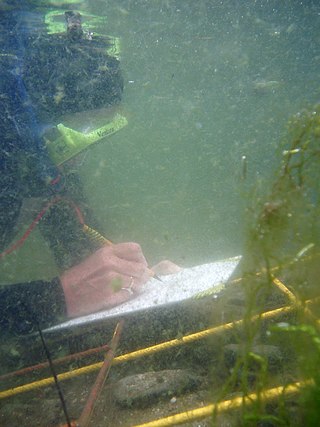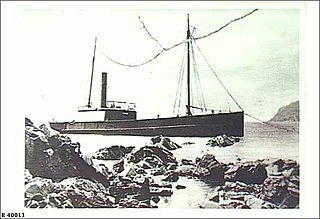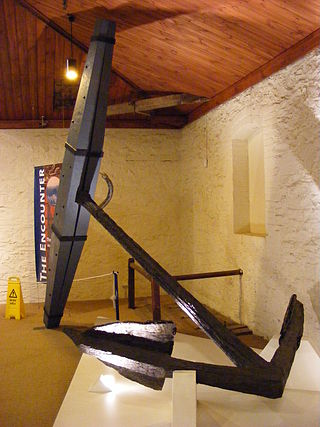Related Research Articles

Underwater archaeology is archaeology practiced underwater. As with all other branches of archaeology, it evolved from its roots in pre-history and in the classical era to include sites from the historical and industrial eras.
Suhr can refer to:

The Archaeology Discover Centre was a museum located in Fort Victoria on the Isle of Wight, England.

HMS Buffalo was a storeship of the Royal Navy, originally built and launched at Sulkea, opposite Calcutta, in 1813 as the merchant vessel Hindostan. The Admiralty purchased her that year after she arrived in Britain. She later transported convicts and immigrants to Australia, before being wrecked in 1840.

Dr Margaret Helen Rule, was a British archaeologist. She is most notable for her involvement with the project that excavated and raised the Tudor warship Mary Rose in 1982.

George Robert Fischer was an American underwater archaeologist, considered the founding father of the field in the National Park Service. A native Californian, he did undergraduate and graduate work at Stanford University, and began his career with the National Park Service in 1959, which included assignments in six parks, the Washington, D.C. Office, and the Southeast Archaeological Center from which he retired in 1988. He began teaching courses in underwater archaeology at Florida State University in 1974 and co-instructed inter-disciplinary courses in scientific diving techniques. After retirement from the NPS his FSU activities were expanded and his assistance helped shape the university's program in underwater archaeology.

Loch Vennachar was an iron-hulled, three-masted clipper ship that was built in Scotland in 1875 and lost with all hands off the coast of South Australia in 1905. She spent her entire career with the Glasgow Shipping Company, trading between Britain and Australia. The company was familiarly called the "Loch Line", as all of its ships were named after Scottish lochs. The ship was named after Loch Venachar, in what was then Perthshire.
Site Recorder is a geographical information system (GIS) and information management system (IMS) designed for use in maritime, freshwater and intertidal archaeology. Site Recorder can be used on maritime and intertidal archaeology projects for real-time data collection, decision support, publication, archiving and data migration. The program is designed for use by archaeologists rather than GIS experts.
Samir Alhafith is an Australian technical diver, cave explorer and underwater filmmaker. He is the founder and team leader of the Sydney Project - an association of technical divers involved in researching and discovering important historical wrecks in depths between 75 and 135 metres on the south coast New South Wales.

Peter Christopher, OAM, is an Australian author and photographer who writes about shipwrecks and riverboats. He is also a Director of the not for profit organisation, Clipper Ship City of Adelaide Ltd (CSCOAL), set up to save the 1864 clipper ship, City of Adelaide.

The Underwater Archaeology Branch (UAB) of the Naval History & Heritage Command (NHHC) is a unit of the United States Department of the Navy. It was formally founded in 1996 as a consequence of the emerging need to manage, study, conserve, and curate the U.S. Navy's submerged cultural resources.

Agnes Milowka was an Australian technical diver, underwater photographer, author, maritime archaeologist and cave explorer. She gained international recognition for penetrating deeper than previous explorers into cave systems across Australia and Florida, and as a public speaker and author on the subjects of diving and maritime archaeology. She died aged 29 while diving in a confined space.
David Godwin Burchell BEM was a South Australian business man, a recreational scuba diver and a football administrator.
The Society for Underwater Historical Research (SUHR) was an amateur maritime archaeology organisation operating in South Australia (SA). It was formed in 1974 by recreational scuba divers and other persons to pursue an interest in maritime archaeology and maritime history. The SUHR was renamed as the South Australian Archaeology Society in March 2012 as part of a plan to expand its activities beyond maritime archaeology to include other archaeological disciplines.

Ellen was a steamship that was launched in 1883 and whose career involved coastal shipping firstly in the Colony of Queensland and then in the Australian state of South Australia. It was wrecked in Gulf St Vincent in South Australia at Morgan's Beach near the town of Cape Jervis on Saturday, 12 December 1908 during its return from fishing in waters around Kangaroo Island to a destination on the mainland.

The HMS Investigator Anchors are the two anchors that jettisoned from HMS Investigator on the morning of Saturday, 21 May 1803, by her commander, Matthew Flinders, in order to avoid running aground on Middle Island in the Archipelago of the Recherche on the south coast of New Holland. In 1973, the anchors were located and recovered by members of the Underwater Explorers Club of South Australia (UEC). The recovered anchors became the subject of an ownership dispute between various governments, particularly those of South Australia and Western Australia due to their historic significance as artefacts of a major voyage of European exploration. The dispute was resolved with the ownership of the anchors going to the Australian Government who subsequently gifted one of the anchors to the South Australian Government. The pair of artefacts is also known as Flinders' Anchors.
Water Witch was a single-masted vessel rigged as a cutter built during 1835 in Van Diemen's Land and sunk in 1842 whilst moored in the River Murray at Moorundie, south of Blanchetown in South Australia (SA). Her wreck site was discovered in 1982 and received statutory protection as a historic shipwreck in 1983. The wreck site was the subject of an underwater survey in March 1984. She was the first European vessel to enter the River Murray via its mouth, her role in the charting of the lower reaches of the River Murray including Lake Alexandrina whilst under the command of William Pullen and her association with Edward John Eyre.

Lady Kinnaird was a three masted barque which was built in 1877 at Dundee, Scotland by Brown & Simpson for W.B. Ritchie. She operated between the United Kingdom and the Australian colonies. She was lost after running aground in Spencer Gulf south of Cape Burr on the east coast of Eyre Peninsula in South Australia early on 21 January 1880. Her main anchor was recovered from her wreck site in 1979 and was placed on display in the nearby town of Port Neill in January 1880 as part of the commemoration of the centenary of her loss.

HMS Swift was built in 1762 at the shipyard of John Greave in Limehouse, on the banks of the River Thames, and launched in 1763. It was a sloop-of-war 28 metres (92 ft) in length and was armed with 14 6 pounders (2.7 kg) guns and 12 pedreros of 1⁄2 pound. It sank along the coast of Puerto Deseado, Patagonia in 1770.

Graeme Henderson is an Australian maritime historian and maritime archaeologist. Since the early 1970s he played a leading role in developing maritime archaeology and maritime museums in Australia, having assisted in, or led the investigation of wrecks in the Fremantle area as well as on the Western Australian coast, on islands offshore and in the Eastern States. Henderson was the first Director of the new Western Australian Maritime Museum on Victoria Quay from 1992 to 2005.
References
- ↑ ‘Letter to Society for Underwater Historical Research Committee’ in the SUHR Newsletter for April 1982,Cowan, David (editor); (2007), The Society for Underwater Historical Research – Publications 1974-2004.
- ↑ ‘Minutes of the General Meeting held … on Tuesday 27 April 1982’ in SUHR Newsletter for May 1982,Cowan, David (editor); (2007), The Society for Underwater Historical Research – Publications 1974-2004.
- ↑ ‘Minutes of the General Meeting held … on Tuesday 25 May 1982’ in SUHR Newsletter for May 1982 in Cowan, David (editor); (2007), The Society for Underwater Historical Research – Publications 1974-2004.</
- ↑ Opening page of the SUHR Newsletter for May 1982 in Cowan, David (editor); (2007), The Society for Underwater Historical Research – Publications 1974-2004.
- ↑ ‘Minutes of the General Meeting held … on Tuesday 25 May 1982’ in SUHR Newsletter for May 1982 in Cowan, David (editor); (2007), The Society for Underwater Historical Research – Publications 1974-2004.
- ↑ 'SA team seek Buffalo wreck', Advertiser, 9 April 1986, p.12.
- ↑ 'Divers find parts of the Buffalo', Advertiser, 17 April 1986, p.10.
- ↑ Jeffery, W. (1989), Report on survey of HMS Buffalo wrecksite (1813-1840): Bulletin of the Australian Institute for Maritime Archaeology.